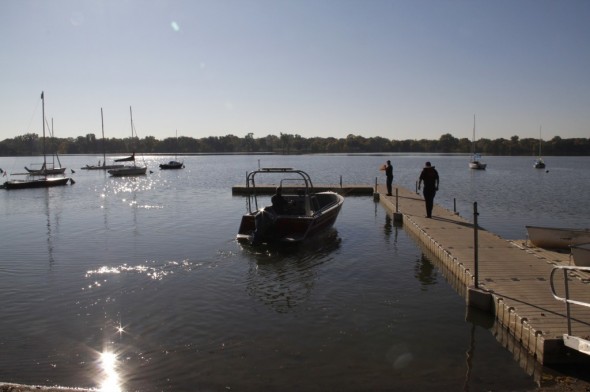The Hunt for Endocrine Disruptors
Study of Minnesota's lakes finds chemical levels that are likely to be found in Wisconsin.

Lake Nokomis in Minneapolis, shown here in October 2012, is popular with swimmers, fishermen and boaters, but — like most Minnesota lakes — it contains a cocktail of troubling chemicals at trace amounts. Kate Golden/Wisconsin Center for Investigative Journalism
Water Watch Wisconsin
These stories launch a major new project, Water Watch Wisconsin. The Wisconsin Center for Investigative Journalism, Wisconsin Public Radio and Wisconsin Public Television are examining the quality and supply of Wisconsin’s water. Story ideas? Email water@wisconsinwatch.org.
Related Stories
- Minnesota Study Scares Wisconsin
- DNR Doesn’t Test Wisconsin Waters for Hormone-Disrupting Chemicals
- Why Experts Avoid Alarm on Hormone-Disrupting Chemicals
Links and resources on endocrine disruptors
- National Resources Defense Council fact sheet on endocrine disruptors
- e.hormone Comprehensive endocrine disruption tutorials and links from Tulane University
- Q&A for families on endocrine disruptors From the Emory University Pediatric Environmental Health Specialty Unit
- U.S. Health and Human Services Q&A about soy infant formula
- The Endocrine Disruption Exchange
- The impact of endocrine disruption: Consensus statement on the state of the science April 2013
- EPA’s Endocrine Disruptor Screening Program
On a midsummer morning last year at popular Lake Nokomis in Minneapolis, Mark Ferrey dipped a brown glass bottle into the water. His hands were gloved, he had drunk no caffeine, he wore no insect repellent. The slightest contamination would ruin the sample.
Below the sparkling surface swam muskies and walleye. Triathletes would be swimming there the next day. But Ferrey, a Minnesota Pollution Control Agency researcher, knew his sample would most likely turn up a cocktail of chemicals at trace levels.
According to results released last week, the Nokomis water was contaminated that day with a component of plastic, ibuprofen, a disinfectant used in hand soap, an antibiotic used on swine, a breakdown product of cocaine, an antidepressant, a fungicide and a drug used to treat Parkinson’s disease.
Some of the Nokomis cocktail’s most worrisome ingredients, the plastic component bisphenol A (BPA) and the disinfectant triclosan, are likely endocrine disruptors, chemicals that can interfere with the body’s hormone system.
Potent at extremely low concentrations, they can cause male fish to develop female characteristics. Because the endocrine system regulates a wide variety of the body’s functions, scientists have pegged them as possible causes for a host of health problems in wildlife and people.
When Ferrey started looking for endocrine disruptors in a dozen Minnesota lakes in 2007, he found them in every one — even the remote ones that were supposed to be pristine reference lakes.
That meant they “may not be as pristine as we were thinking,” Ferrey said.
In that first study, Ferrey’s collaborators lowered cages of male lab minnows into the lakes. After three weeks, most of them became feminized.
They produced an egg yolk protein that normally only females make. Some of them grew egg cells in their testes, or made fewer sperm. It was not just the lab fish — the resident sunfish, perch, minnows and shiners showed the effects of exposure to something like the hormone estrogen, too.
That prompted more research.
Ferrey, working with the U.S. Geological Survey and university scientists, sampled streams and rivers and found estrogenic chemicals downstream of wastewater treatment plants — and upstream, too.
In summer 2012, his agency sampled 50 more lakes, including Nokomis, with U.S. Environmental Protection Agency funding. A colleague is testing groundwater.
Nokomis was hardly unique. Ferrey found some chemicals in all but three lakes, and found 38 of the 125 largely unregulated chemicals he looked for. In a separate study of streams and rivers, Ferrey found 18 personal care products or pharmaceuticals.
Environmental experts said Minnesota’s results put pressure on Wisconsin to find out what’s in the water here.
Susan Sylvester, head of the Wisconsin Department of Natural Resources’ surface water bureau, told the Wisconsin Center for Investigative Journalism she was “impressed” by what the Minnesota researchers were able to show —†but didn’t have the money for such monitoring.
“I think that we could probably assume that if we looked for these chemicals, we would find similar kinds of products as well,” Sylvester said.
Many possible sources
By 2011, Ferrey’s team had reported finding ethinylestradiol, a synthetic contraceptive hormone commonly taken by women, in the water downstream of Minnesota wastewater treatment plants about 40 percent of the time.
Wastes from these plants are full of these chemicals. Treatment systems were not designed to remove endocrine disruptors and other pollutants, like pharmaceuticals and personal care products, that are often referred to in the scientific literature as “contaminants of emerging concern.”
The Minnesota researchers also found chemicals upstream, which means treatment plants were not the only source.
Ferrey’s latest study is unusual because he selected the 50 lakes randomly, instead of choosing those most susceptible to contamination. Many had no direct influence from wastewater treatment plants, or even public access.
Other possible sources are agriculture, industry, urban stormwater runoff and near-shore development. Even airborne particulate matter is suspect; Ferrey believes that may be why trace amounts of cocaine contaminated a third of the lakes he examined.
But for many of the chemicals, the sources were unclear. Minnesota has plenty of pigs —†but how carbadox, an antibiotic approved only for use on swine, got into 28 percent of the lakes was ultimately “perplexing,” Ferrey wrote. Many were nowhere near livestock facilities.
Article Continues - Pages: 1 2
-
Legislators Agree on Postpartum Medicaid Expansion
 Jan 22nd, 2025 by Hallie Claflin
Jan 22nd, 2025 by Hallie Claflin
-
Inferior Care Feared As Counties Privatize Nursing Homes
 Dec 15th, 2024 by Addie Costello
Dec 15th, 2024 by Addie Costello
-
Wisconsin Lacks Clear System for Tracking Police Caught Lying
 May 9th, 2024 by Jacob Resneck
May 9th, 2024 by Jacob Resneck





















